Earlier this spring, Ann Lewis drove from Detroit to Boston to create a four-story mural. This wasn't just any mural. Lewis would paint the mural on a building in Boston's historic South End and would work with residents of the McGrath House (a re-entry residence run by Community Resources for Justice for formerly imprisoned females) to create its design. Over two workshops, the women created collages from Lewis's prompts for them: "Who I Am Now” and “Who I Want To Be In The Future.” From those collages Lewis created See Her, a black, white, red, and gray mural focused on an image of Laura, one of the women from McGrath House.
I spoke with Lewis a few weeks ago to discuss her previous works (which include installation, painting, and performance), as well as her process and thematic focus of See Her. Talking about the distinction between activist or socially engaged art making, material as it relates to form and concept, Lewis described how prisoner torture at Abu Ghraib motivated her earliest works, and how that same drive for a voice and visibility for incarcerated people continues to inspire her. Our edited conversation is below.
Leah Triplett Harrington: My first question for you is about your previous work. How did you start working as an activist, or with socially engaged practices? What came first, your artwork, then activism?
Ann Lewis: I went to art school, originally I went to school as an engineer, but hated that and got into art. I graduated and moved to New York and still wanted to do engineering stuff, or designed-based stuff, versus specifically art. But then the Bush administration was torturing people and Abu Ghraib prison happened. I felt voiceless.
LTH: When did you move to New York?
AL: 2004. So I started doing street art to sort of use that as a tool to have conversations. I wasn’t able to have them with my community because I hadn’t really connected with the right people yet, so I started cutting stencils and doing wheat paste to be able to talk about what I needed to. I had the skills and the tools do it, but I wasn’t until I wanted to be an activist [that I started making this work]. Literally, every piece of artwork I’ve ever made is some sort of statement.
LTH: Were you working in the public realm when you were in school?
AL: No, not at all. I was working on graphic design and furniture design. I was very heavily designed focused.
I don’t see myself as a painter, I am multi-disciplinary. I was doing a lot of different things in art school, but not particularly focusing on one thing. I was dabbling. I think that’s actually transferred into my practice because I do a lot of multidisciplinary work now. It’s not always painting, it’s not always installation, it changes depending on what I’m talking about. I think I’ve always wanted to be trying new things.
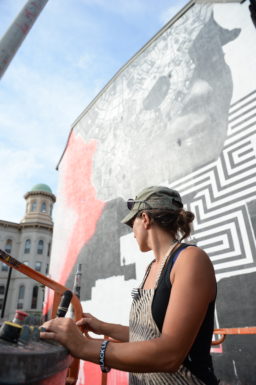
Ann Lewis working on See Her. Photo courtesy of Now + There. (c) Ryan McMahon
LTH: That’s something that I wanted to talk to you about, the role of painting in your work. But first, do you see a difference between activist art and socially engaged practices? How do you define both?
AL: I think they’re kind of similar beasts, you know? Socially engaged practice can be activism focused, or it can just be about engaging the community. I think a lot of people would consider that activism, while a lot of other people wouldn’t. I think it really depends on the viewer or the perspective of whoever is looking at the project.
I have a lot of friends who are teachers, art teachers, and they work with kids all the time. But I don’t know if they really consider themselves activists. I do, I consider them activists. I think there’s a lot of nuance around these sorts of ideas. For me personally, my social engagement in my practice is definitely activist, because I’m actively focusing on working with communities that have been disempowered or are hidden or silenced.
LTH: I feel like socially engaged and activist practices are so interconnected, but lately there’s an attempt to differentiate the two. It’s like activist art has to be more visual in the sense that it’s seen more, it’s somehow more aggressive, but socially engaged work is much more open-ended. It can be a movement or a subtle action. But activist art is less outcome focused and more…
AL: Reactionary?
LTH: Yes, reactionary, that’s a good word.
AL: I think I’ve spent a lot of time being reactionary in my work, specifically in the beginning. Something would happen and then I’d make a piece about it. And now I find that it’s really important to look at the issue and create a piece that helps other people see solutions.
I did a piece last year that was toe tags [...and counting] for every single person who was killed by police. I wanted people to see the humanity in that. When I went into it I was like, fuck the police. Then I read every single story.
LTH: I don’t know what that must have done to you.
AL: It crushed me. I didn’t make work, I just didn’t have anything left in me. But that’s nothing compared to the people who are destroyed by these stories. These are their real lives, I just had to read about it and write it on a toe tag. But seeing each individual issue, repeated and repeated...so many people were unarmed, but a majority of them were armed. 60% of the people who died were armed. If you have a gun on you and the cops show up, you’re much more likely to get killed. Many people were suicidal, and they’d call the cops saying that they have a gun and get killed. Many people had PTSD or mental health issues that weren’t being addressed. All these people are dying, but it’s because we aren’t taking care of them beforehand. It made me see the issue clearer. I think that’s part of why I did it because I didn’t understand all of it.
LTH: Have you read the book Ghettoside? When I was reading about the toe tag project I was reminded of it. An LA reporter decided to go every shooting related death for one year. In the afterword, she writes about driving around in her car feeling like she was driving in statistics. Just living data. She similarly tried to report the story and put them into context in terms of the core issue behind police brutality and poverty.
AL: [The police] have no idea how to understand what illnesses people have. They aren’t trained at all. They get about eight hours of mental health training in their whole training, even though the majority of the people they deal with have a mental illness. And they also need mental health support, because they go through all sorts of trauma.
LTH: I also wanted to ask you about the material of your projects. I’m sure you know much more about this than I do, but I feel like there’s starting to be a conversation around the formalism and material of activist or socially engaged practices. Could you a little about your material or form relate to the participatory aspects of your projects? Looking at ...and counting & One in Five of Us, the materials are so striking, and I think they create an urgency or immediacy that a painting wouldn’t.
AL: I think after so many years as a street artist, putting stuff on a wall that people would or wouldn’t look at, felt increasingly more passive. They can be completely ignored and walked away from. Whereas, when you engage people physically, and you create an experience for them, they are far more likely to remember that experience than the image. At least for me. For me, the most poignant aspects of my life stem from experience. The mural [See Her] is a very large piece, and I’m shifting towards creating more experiences because I think that’s where you trigger more emotions and people walk away feeling like they need to do something. But a four-story mural is hard to ignore, and I love the idea of making an image of an incarcerated woman so large and public because that will drive attention.
A huge goal of mine as an activist artist is to make sure people walk away choosing to want to engage in the subject matter in a way that can change or help people.
The toe tag project was beautiful, but no one wanted to walk through it. They didn’t know that they could. I’m actually doing a residency at the Santa Fe Institute next winter, and my entire project there is thinking about how to develop installations that people want to engage with. I’m thinking about how I form the space. Because that’s where I think it can be a successful piece, or an exponentially successful piece if it’s designed properly. And you have to be able to understand how people interact with space. That’s something that I’m really focusing on in the next couple months.
LTH: So going back to murals…obviously murals, or the tradition of murals, have a long history of politics and activism. I’m thinking of course of Diego Rivera, and how that tradition is also intertwined with capitalism, and now gentrification. So how do you reconcile those aspects, and how do they inform what you are doing in the South End right now?
AL: Well, I’ve had a lot of experience watching my old neighborhood in Bushwick go from an artists’ community to a super corporate space. I think in the beginning I was a hand in that gentrification without realizing it, and once I saw what was happening, I stopped. I didn’t want to contribute to displacing my community. I think there are many ways that muralism can gentrify, and shift the demographic. So when Kate [Gilbert] and I were talking about the neighborhood and how it’s predominantly black, she asked me about how I would represent the community in a way that is meaningful. As a white woman from the outside, I don’t understand their stories or situations. I responded that we have to engage the community. That’s the only way. I’m not going to just walk in and slap something on the wall and talk about the history of the neighborhood. That feels disconnected from the present reality.
I immediately went into the social justice realm in Boston and looked at the institutions that were around. And I found the McGrath House, which is in the neighborhood. So I thought about how I would use my skills to amplify the voices of these people who are totally hidden away, even though they are in the community and are literally walking by you every day. They’re inmates. They have so many restrictions on them as they finish up the last six months of their sentences, so I thought it was an interesting way to connect the activism work that I do, but to talk to people in the community.
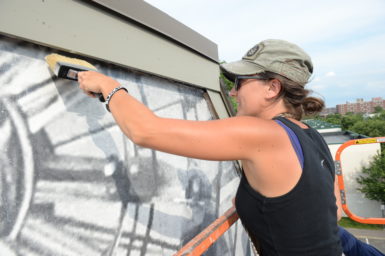
Ann Lewis working on See Her. Photo courtesy of Now + There. (c) Ryan McMahon.
One of the first days we were on the wall, this kid walked up and said, “so, you’re going to paint over the graffiti?” And I responded that I didn’t know, but I explained the story. He told me that his aunt was in the McGrath House. So there was already a connection to the neighborhood even when we are still developing.
LTH: I think murals do have an accessibility that installations or other ‘art’ doesn’t have.
AL: Right, if you’re not going to the ICA, and many communities don’t have the expendable income to go do something like that. So if you’re putting work out in the public, it has to speak to the people who live there.
LTH: What do you see as the outcome of See Her? What do you hope it achieves? Or are you thinking more about process?
AL: It’s been literally just process for weeks. But overall, in the broader scope of my work, I like to use my projects to raise awareness and push the conversation to places people won’t go without being confronted.
This mural is meant to recognize there is value in everyone. Just because you have been incarcerated for some mistake you made, doesn’t mean you are a bad person, or that you shouldn’t be offered an opportunity to become part of the community again. This whole country is nothing but judgment right now, and I think there needs to be more space for empathy and compassion.
I had to talk to someone who said I was basically putting a most wanted poster up on the wall. And it’s not, it’s someone who is a human being.
LTH: Who is coming back into the world from a place where the idea is rehabilitation.
AL: There are so many ways to view incarceration, and I think ultimately unless people are given the facts, they just assume bad things. It’s easy to not think about it and go about your life because you don’t see a prison [in your neighborhood]. You don’t see inmates because they are totally tucked away from our experiences.
Specifically women, too. When we talk about incarceration we talk about men. We don’t think about when women go away, and what happens to the families that they hold together and keep going.
LTH: You’ve worked with incarcerated people before, right?
AL: I’ve worked with Young New Yorkers. The first project I did around mass incarceration was called Autoincarceration. It was a thirty-day performance in which I spent each day, all day, in an orange jump suit. I would walk around and talk to people about mass incarceration. And there was a lot that I learned and a lot that I was able to teach people.
I read a book by Michelle Alexander called The New Jim Crow, and I felt like, “how can I not do something about this?”
LTH: That’s really intense, walking around in an orange jumpsuit all day.
AL: Yes. I would go back into the studio and draw or write on the jumpsuit. So each jumpsuit has different stories. One entirely about Kalief Browder, a sixteen-year-old who got picked up for stealing a backpack. It turns out he didn’t steal the backpack, but he was thrown into Riker’s for three years because he wouldn’t take a plea deal because he maintained his innocence. He was in solitary confinement for two and a half of those three years, and he got out. He had tried to kill himself a few times while he was in prison, but was successful when he got out. He was eighteen or nineteen. I did a mural about him. These stories are so important.
LTH: So how did the women you worked with at the McGrath House inform the design of See Her?
AL: They all made two different collages, one to present “my present self,” and “my future self.” Many of them talked about climbing a ladder or ascending out of where they are, while many were pulling words and creating stories. So I brought all of their collages back to my studio and the thing that kept coming up for me was choices.
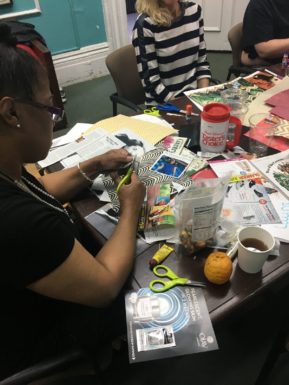
A workshop in progress. Courtesy of Now + There. Photo by Kate Gilbert.
I often incorporate aspects of the surrounding space in my work. I’m really attracted to light fixtures, and that seems to be a recurring theme. [The McGrath House has] a really beautiful chandelier in the foyer, so I often use elements like that for abstract references. I photographed a few ladies who let me photograph them, combing through those to develop some ideas. The picture of Laura is a three-quarter view, she’s looking over shoulder at me as if she’s wondering “who are you,” but also open. I really appreciated this guarded optimism. In terms of the wall, she literally looks down on Tremont Street. The maze at the bottom fits “choice” inside of it and includes a staircase element, referencing the women’s collages.
LTH: When did you start using the maze as a motif?
AL: I’ve been doing mazes for years but I just started incorporating them into collage or photographic work. This is part of a series called The Matriots series, meant to discuss the matriot as a female energy dedicated to overall life and support of everyone regardless of their nation-state. It piece has a photographic element, and then I figure out the word that works with her story and turn that into a maze.
I like the mazes because they are sort of a subliminal conversation. I started them first to counteract the subliminal message of advertising. I felt like to create them in public spaces could somehow counterbalance the overwhelming, constant badgering of “buy this, do this, be this person, look like this.” I try to use positive messaging in them. Whether people see it or not is the fun part. It’s a good way to engage people in a very passive medium.
LTH: And the word in the maze for this project is a choice?
AL: Yes, so we have a choice to reconfigure how we are speaking to or about incarcerated people. And they have the choice to shift the way that they are living their lives. And they seem very excited to do so. The ways that these women now have to navigate their lives is very different because many opportunities are closed, especially if they are felons. The entrepreneurial spirit that I heard and saw during the workshops was really awesome. Their creativity is valuable, and they need to know that they’re valuable.
See Her is a project of Now + There and will be on view at 808 Tremont Street through October 2018.
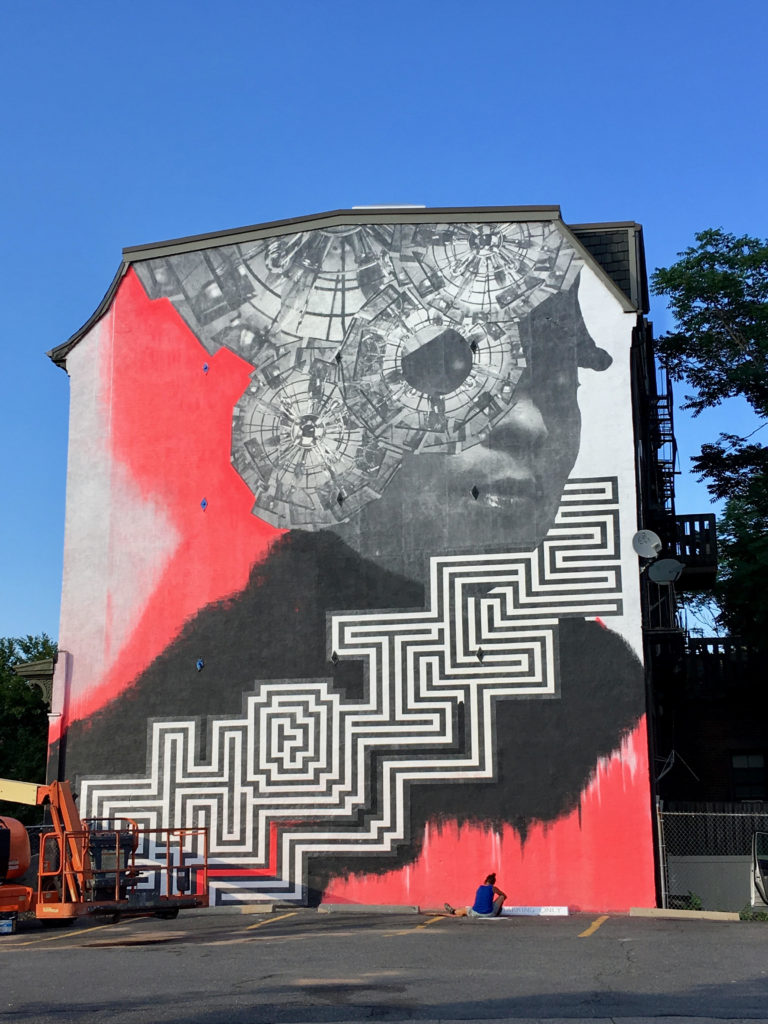
See Her. Courtesy of Now + There, photo by Silvia Lopez Chavez.

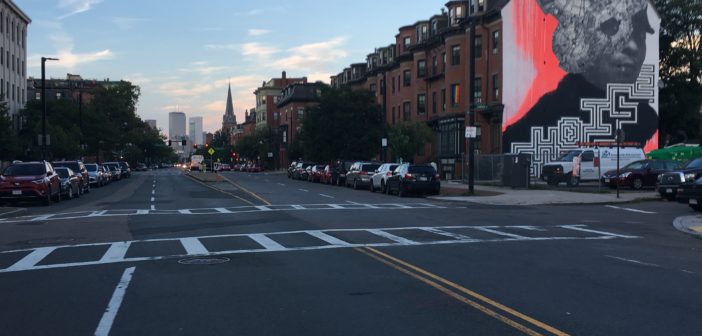



1 Comment
Great interview, and compelling portrait of this activist artist. I couldn’t help thinking about the recent, highly-publicized, suicide death in Hingham (Austin Reeves) when I looked at the work “Toe Tags” on her website. That incident happened only a week before this was published.